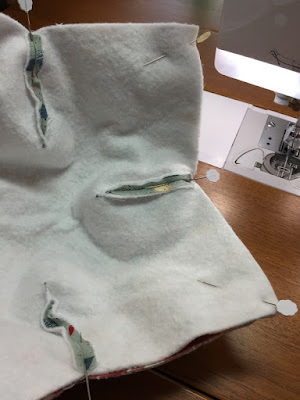My daughter likes these little microwave soup bowl holders that are all over Pinterest. There wasn't time to make some for her Christmas, but January is a good soup month. This was also a super way to use some of those 10" precuts that I keep collecting.
I was having fun, so when the bowls were finished, I made a bread basket to match, and gave it button-on handles that can be placed up or down. Then I added a reversible napkin for the bread basket. Playing with my favorite toys is always fun.
I haven't made a pattern for the bread basket, because it isn't all that impressive, but I will be playing with more basket ideas in the future.
I did make an actual pattern for the soup bowl holders, though. The idea of drawing lines from corner to corner and side to side on each 10 inch square seemed a bit much. A pattern shortened the process considerably, and the measuring was finished when the pattern was done.
Make a pattern for 10" fabric squares.
1. Cut a 5" x 10" rectangle from your paper. Draw a dotted down the center to make two 5" x 5" squares.
2. Measure 2 1/2" down from the top on the dotted line. Make a dot.
3. At the very top of the dotted line, measure 1" to either side of the line and make dots.
4. Make dots 1" up from the bottom on each side edge of the paper.
5. Make dots 2 1/2" in from each bottom side edge of the paper.
6. Connect the dots. These are the stitching lines for the darts.
7. Measure exactly 1/4" to the inside of each dotted line and cut.
8. Two pattern sections can be taped together for a complete pattern.
Cut and sew the bowl holders:
1. Place a 10" x 10" square of fabric right side up on a piece of 100% cotton batting.
3. Mark the dots for the inside corners on the batting with a fabric marker or ball point pen.
6. Pin two of the fabric/batting sections right sides together. Using a 1/4" seam, stitch all the way around leaving about a 4" opening to turn the soup holder right side out.
7. Turn, stitch the opening closed, and press.



















































